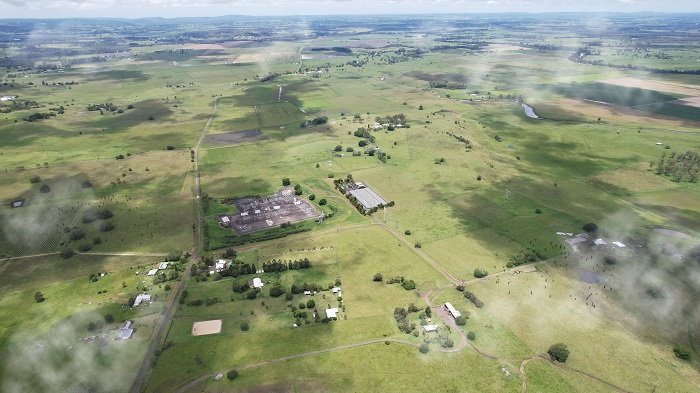ABOVE: Maoneng released an artist’s image of the McKees Hill big battery, which sits to the right of the Lismore substation – the larger site on the left of the image.
Susanna Freymark
An image of how the McKees Hill big battery will look when completed has been released by the company building it.
The artist’s impression shows the completed battery project covering 1.5ha next to the Lismore transmission substation on Auckram Rd.
The battery project will use the Lismore 330kV transmission substation. The company behind the battery project, Maoneng has said the battery will charge and discharge from the national electricity market and will not have a generation component such as a solar or wind farm.
The construction of the battery is expected to take 12 months.
Not all residents want the project to go ahead.
Maoneng’s Alex Godina said the company was finalising the Environmental Impact Statement package for the development application to the NSW Department of Planning, Industry and Environment.
“This package includes all the important information of the proposed project and the assessment of the potential impacts including visual, social, noise, hazards and safety, heritage, soils and water, traffic and biodiversity,” Mr Godina said.
Once accepted and published by DPIE, the formal community exhibition process begins, he said.
“This is the formal and legislative time that everyone will have all the proposed project details available to them and will be able to give their feedback on the project.”
After this time, Maoneng will then have to respond formally to all the feedback including from neighbours, the wider community, and the other bodies such as EPA, council, roads, biodiversity division, Mr Godina said.
Maoneng has completed their website. Documents and 3D drawings as well as frequently asked questions are on the site.
Two questions residents have raised are:
What if the batteries catch fire? (this happened at a battery in Victoria, not owned by Maoneng)
Maoneng said: “Within the battery enclosures are fire detection sensors and a condensed aerosol extinguisher. In the unlikely event of a fire, the aerosol will extinguish the fire by inhibiting the chemical reaction in the fire on a molecular level by removing the flame-free radicals without depleting the surrounding oxygen. The agent itself is environmentally friendly and typically remains suspended in the battery container to help prevent reignition. The materials are non-corrosive, non-conductive and non-toxic and have zero ozone depletion and zero global warming potential.”
Can toxic material spill into groundwater?
Maoneng said: “The battery enclosures, bi-direction inverters, transformers and switchgear equipment will be mounted on concrete hardstands and raised 300mm above the mapped 1 in 100-year flood event. Equipment that contains hazardous chemicals, such as the medium voltage transformers, will be contained within a bund.
“Containment bunds will ensure if transformer oil is spilt, either when undergoing maintenance or operation, oil will not contaminate the environment. In addition, since the transformer oil bunds are open to rainwater, they will have hydrocarbon-absorbent filters for rainwater collected containment bunds.”
Go to the battery website to find out more.




